Business Strategy: Macro Environmental Analysis, Internal Analysis, and Industrial Analysis
VerifiedAdded on 2023/01/12
|13
|3841
|63
AI Summary
This report provides an analysis of TESCO's business strategy, including macro environmental analysis using PESTLE, internal analysis using SWOT and VRIO, and industrial analysis using Porter's Five Forces. It discusses the impact of political, economic, social, technological, environmental, and legal factors on TESCO's operations. It also evaluates TESCO's strengths, weaknesses, opportunities, and threats, and analyzes the level of competition in the retail industry.
Contribute Materials
Your contribution can guide someone’s learning journey. Share your
documents today.
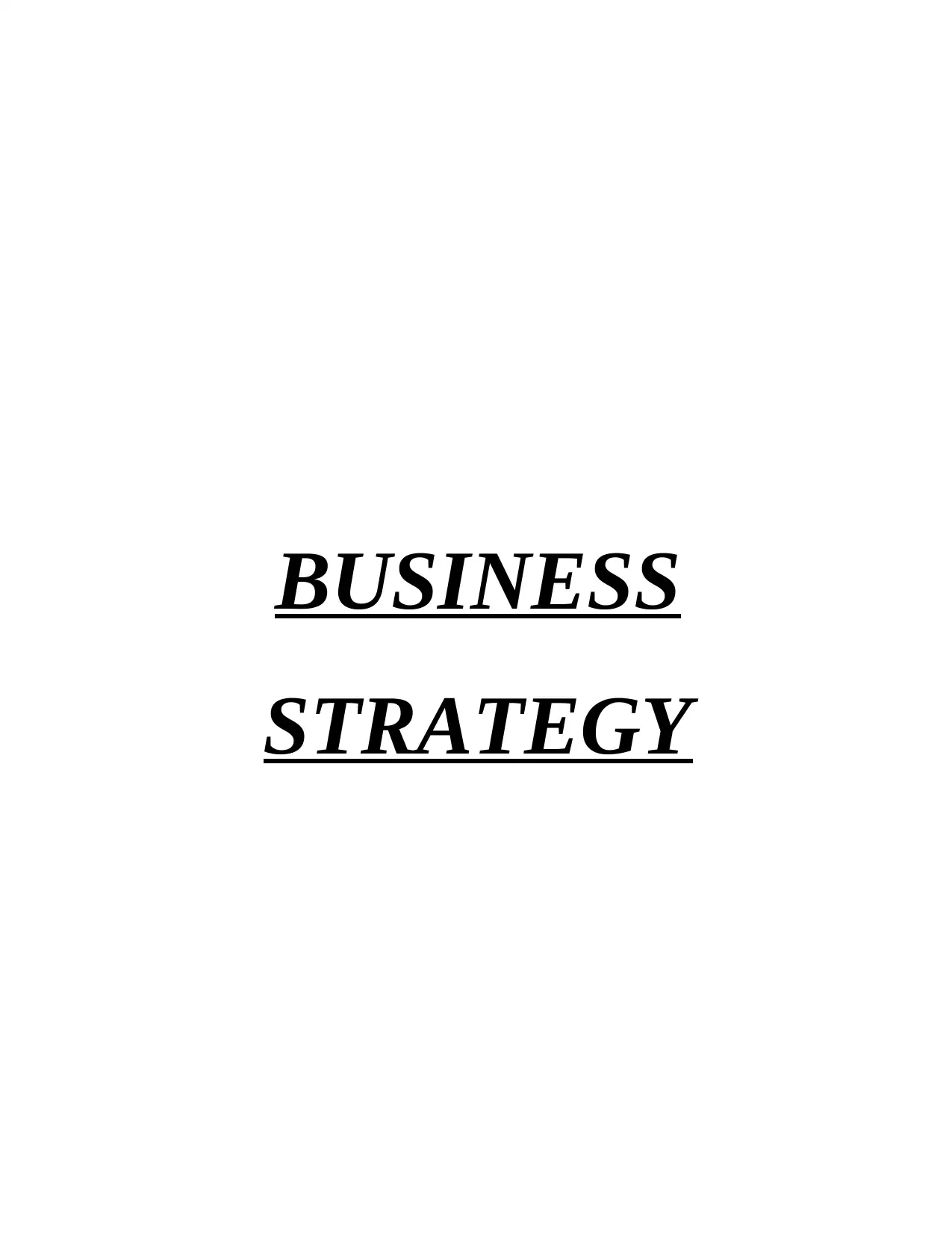
BUSINESS
STRATEGY
STRATEGY
Secure Best Marks with AI Grader
Need help grading? Try our AI Grader for instant feedback on your assignments.
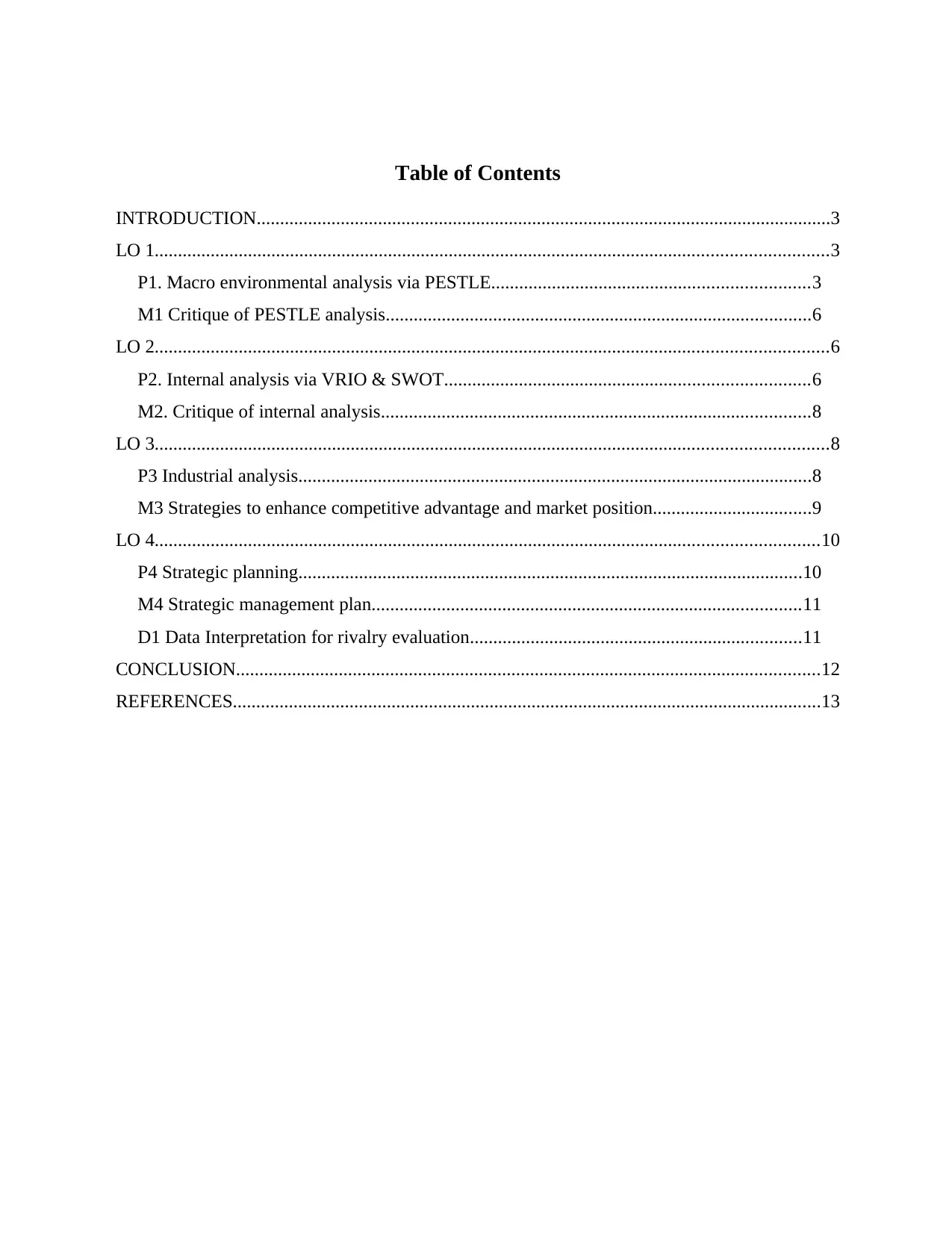
Table of Contents
INTRODUCTION...........................................................................................................................3
LO 1................................................................................................................................................3
P1. Macro environmental analysis via PESTLE....................................................................3
M1 Critique of PESTLE analysis...........................................................................................6
LO 2................................................................................................................................................6
P2. Internal analysis via VRIO & SWOT..............................................................................6
M2. Critique of internal analysis............................................................................................8
LO 3................................................................................................................................................8
P3 Industrial analysis..............................................................................................................8
M3 Strategies to enhance competitive advantage and market position..................................9
LO 4..............................................................................................................................................10
P4 Strategic planning............................................................................................................10
M4 Strategic management plan............................................................................................11
D1 Data Interpretation for rivalry evaluation.......................................................................11
CONCLUSION.............................................................................................................................12
REFERENCES..............................................................................................................................13
INTRODUCTION...........................................................................................................................3
LO 1................................................................................................................................................3
P1. Macro environmental analysis via PESTLE....................................................................3
M1 Critique of PESTLE analysis...........................................................................................6
LO 2................................................................................................................................................6
P2. Internal analysis via VRIO & SWOT..............................................................................6
M2. Critique of internal analysis............................................................................................8
LO 3................................................................................................................................................8
P3 Industrial analysis..............................................................................................................8
M3 Strategies to enhance competitive advantage and market position..................................9
LO 4..............................................................................................................................................10
P4 Strategic planning............................................................................................................10
M4 Strategic management plan............................................................................................11
D1 Data Interpretation for rivalry evaluation.......................................................................11
CONCLUSION.............................................................................................................................12
REFERENCES..............................................................................................................................13
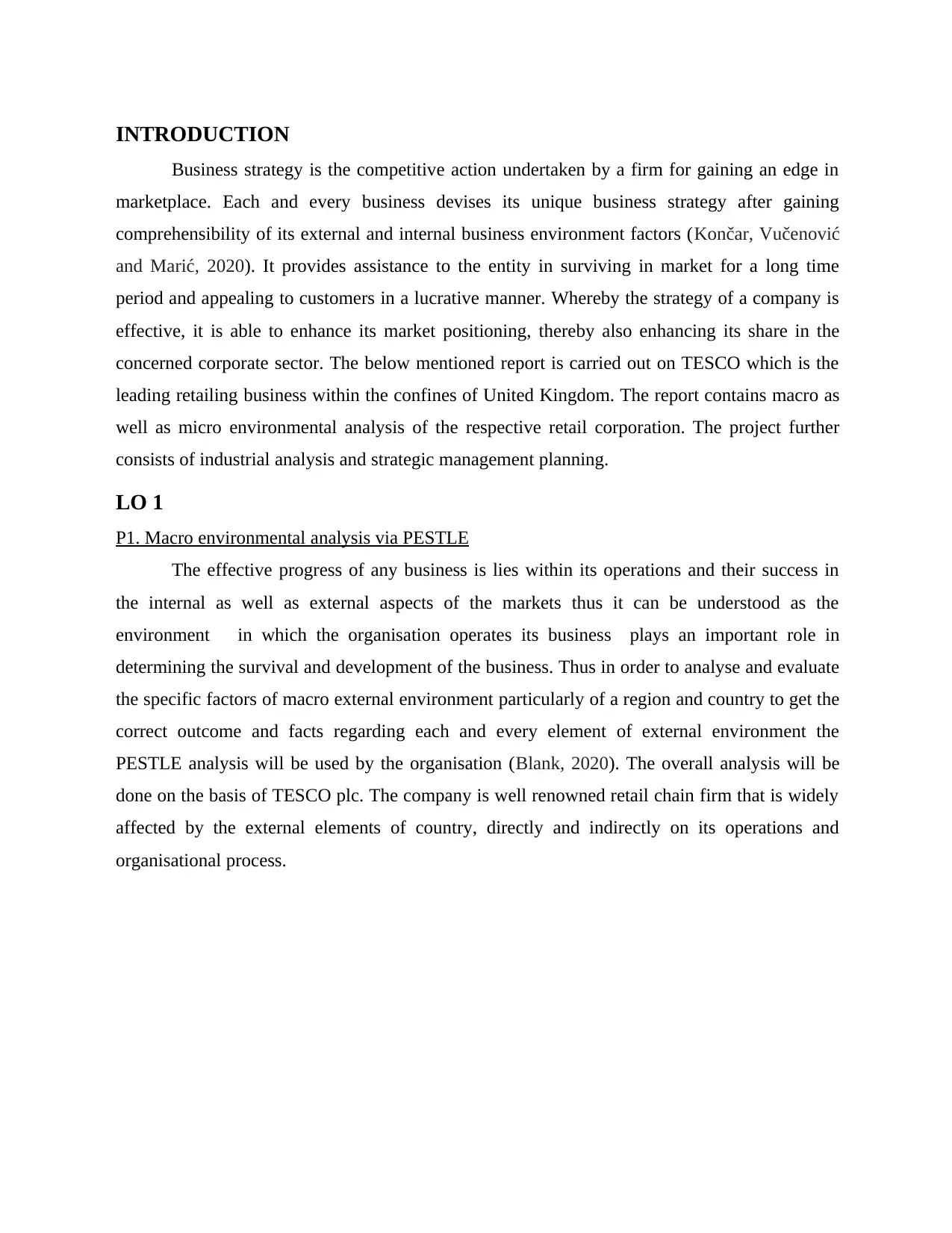
INTRODUCTION
Business strategy is the competitive action undertaken by a firm for gaining an edge in
marketplace. Each and every business devises its unique business strategy after gaining
comprehensibility of its external and internal business environment factors (Končar, Vučenović
and Marić, 2020). It provides assistance to the entity in surviving in market for a long time
period and appealing to customers in a lucrative manner. Whereby the strategy of a company is
effective, it is able to enhance its market positioning, thereby also enhancing its share in the
concerned corporate sector. The below mentioned report is carried out on TESCO which is the
leading retailing business within the confines of United Kingdom. The report contains macro as
well as micro environmental analysis of the respective retail corporation. The project further
consists of industrial analysis and strategic management planning.
LO 1
P1. Macro environmental analysis via PESTLE
The effective progress of any business is lies within its operations and their success in
the internal as well as external aspects of the markets thus it can be understood as the
environment in which the organisation operates its business plays an important role in
determining the survival and development of the business. Thus in order to analyse and evaluate
the specific factors of macro external environment particularly of a region and country to get the
correct outcome and facts regarding each and every element of external environment the
PESTLE analysis will be used by the organisation (Blank, 2020). The overall analysis will be
done on the basis of TESCO plc. The company is well renowned retail chain firm that is widely
affected by the external elements of country, directly and indirectly on its operations and
organisational process.
Business strategy is the competitive action undertaken by a firm for gaining an edge in
marketplace. Each and every business devises its unique business strategy after gaining
comprehensibility of its external and internal business environment factors (Končar, Vučenović
and Marić, 2020). It provides assistance to the entity in surviving in market for a long time
period and appealing to customers in a lucrative manner. Whereby the strategy of a company is
effective, it is able to enhance its market positioning, thereby also enhancing its share in the
concerned corporate sector. The below mentioned report is carried out on TESCO which is the
leading retailing business within the confines of United Kingdom. The report contains macro as
well as micro environmental analysis of the respective retail corporation. The project further
consists of industrial analysis and strategic management planning.
LO 1
P1. Macro environmental analysis via PESTLE
The effective progress of any business is lies within its operations and their success in
the internal as well as external aspects of the markets thus it can be understood as the
environment in which the organisation operates its business plays an important role in
determining the survival and development of the business. Thus in order to analyse and evaluate
the specific factors of macro external environment particularly of a region and country to get the
correct outcome and facts regarding each and every element of external environment the
PESTLE analysis will be used by the organisation (Blank, 2020). The overall analysis will be
done on the basis of TESCO plc. The company is well renowned retail chain firm that is widely
affected by the external elements of country, directly and indirectly on its operations and
organisational process.
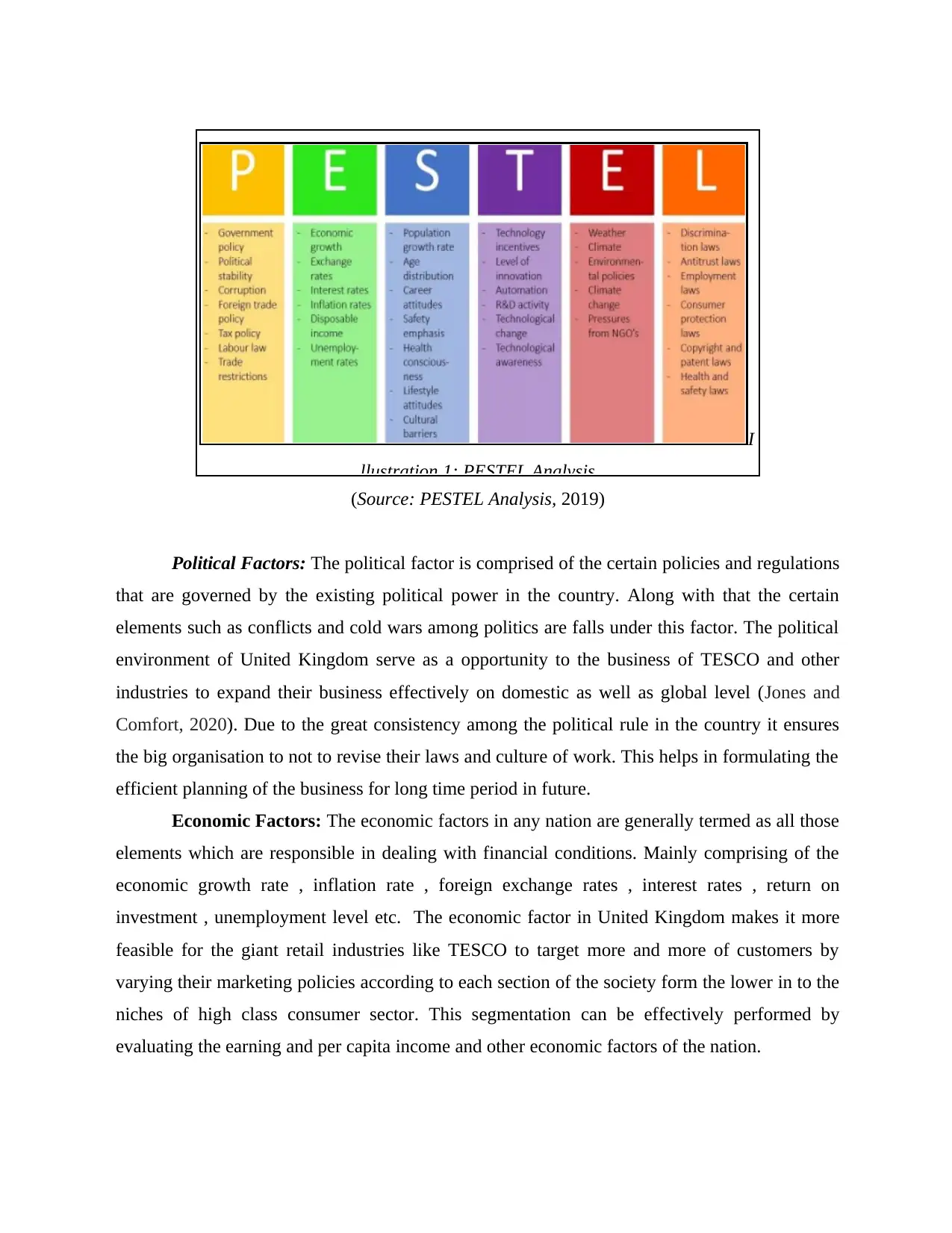
(Source: PESTEL Analysis, 2019)
Political Factors: The political factor is comprised of the certain policies and regulations
that are governed by the existing political power in the country. Along with that the certain
elements such as conflicts and cold wars among politics are falls under this factor. The political
environment of United Kingdom serve as a opportunity to the business of TESCO and other
industries to expand their business effectively on domestic as well as global level (Jones and
Comfort, 2020). Due to the great consistency among the political rule in the country it ensures
the big organisation to not to revise their laws and culture of work. This helps in formulating the
efficient planning of the business for long time period in future.
Economic Factors: The economic factors in any nation are generally termed as all those
elements which are responsible in dealing with financial conditions. Mainly comprising of the
economic growth rate , inflation rate , foreign exchange rates , interest rates , return on
investment , unemployment level etc. The economic factor in United Kingdom makes it more
feasible for the giant retail industries like TESCO to target more and more of customers by
varying their marketing policies according to each section of the society form the lower in to the
niches of high class consumer sector. This segmentation can be effectively performed by
evaluating the earning and per capita income and other economic factors of the nation.
I
llustration 1: PESTEL Analysis
Political Factors: The political factor is comprised of the certain policies and regulations
that are governed by the existing political power in the country. Along with that the certain
elements such as conflicts and cold wars among politics are falls under this factor. The political
environment of United Kingdom serve as a opportunity to the business of TESCO and other
industries to expand their business effectively on domestic as well as global level (Jones and
Comfort, 2020). Due to the great consistency among the political rule in the country it ensures
the big organisation to not to revise their laws and culture of work. This helps in formulating the
efficient planning of the business for long time period in future.
Economic Factors: The economic factors in any nation are generally termed as all those
elements which are responsible in dealing with financial conditions. Mainly comprising of the
economic growth rate , inflation rate , foreign exchange rates , interest rates , return on
investment , unemployment level etc. The economic factor in United Kingdom makes it more
feasible for the giant retail industries like TESCO to target more and more of customers by
varying their marketing policies according to each section of the society form the lower in to the
niches of high class consumer sector. This segmentation can be effectively performed by
evaluating the earning and per capita income and other economic factors of the nation.
I
llustration 1: PESTEL Analysis
Secure Best Marks with AI Grader
Need help grading? Try our AI Grader for instant feedback on your assignments.
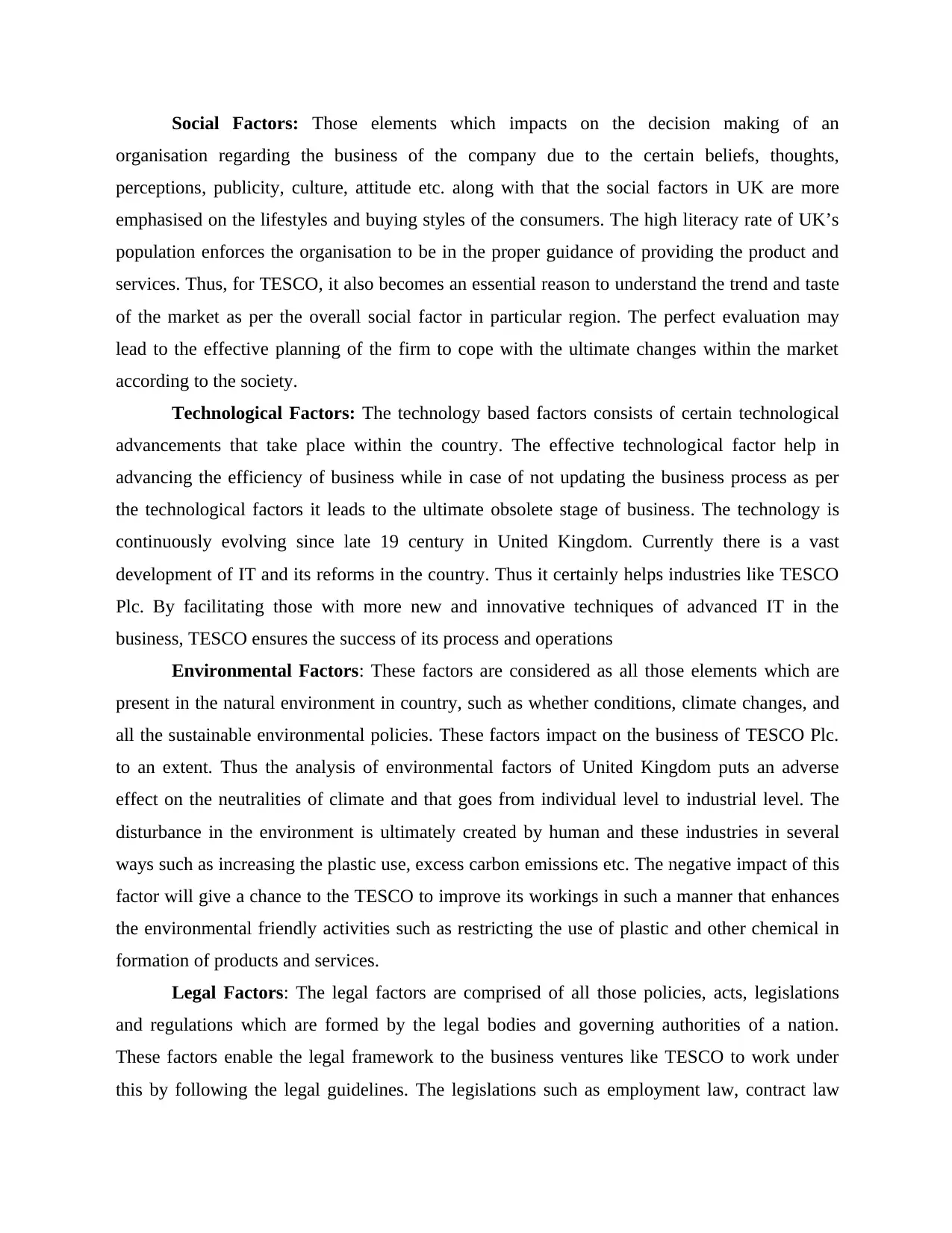
Social Factors: Those elements which impacts on the decision making of an
organisation regarding the business of the company due to the certain beliefs, thoughts,
perceptions, publicity, culture, attitude etc. along with that the social factors in UK are more
emphasised on the lifestyles and buying styles of the consumers. The high literacy rate of UK’s
population enforces the organisation to be in the proper guidance of providing the product and
services. Thus, for TESCO, it also becomes an essential reason to understand the trend and taste
of the market as per the overall social factor in particular region. The perfect evaluation may
lead to the effective planning of the firm to cope with the ultimate changes within the market
according to the society.
Technological Factors: The technology based factors consists of certain technological
advancements that take place within the country. The effective technological factor help in
advancing the efficiency of business while in case of not updating the business process as per
the technological factors it leads to the ultimate obsolete stage of business. The technology is
continuously evolving since late 19 century in United Kingdom. Currently there is a vast
development of IT and its reforms in the country. Thus it certainly helps industries like TESCO
Plc. By facilitating those with more new and innovative techniques of advanced IT in the
business, TESCO ensures the success of its process and operations
Environmental Factors: These factors are considered as all those elements which are
present in the natural environment in country, such as whether conditions, climate changes, and
all the sustainable environmental policies. These factors impact on the business of TESCO Plc.
to an extent. Thus the analysis of environmental factors of United Kingdom puts an adverse
effect on the neutralities of climate and that goes from individual level to industrial level. The
disturbance in the environment is ultimately created by human and these industries in several
ways such as increasing the plastic use, excess carbon emissions etc. The negative impact of this
factor will give a chance to the TESCO to improve its workings in such a manner that enhances
the environmental friendly activities such as restricting the use of plastic and other chemical in
formation of products and services.
Legal Factors: The legal factors are comprised of all those policies, acts, legislations
and regulations which are formed by the legal bodies and governing authorities of a nation.
These factors enable the legal framework to the business ventures like TESCO to work under
this by following the legal guidelines. The legislations such as employment law, contract law
organisation regarding the business of the company due to the certain beliefs, thoughts,
perceptions, publicity, culture, attitude etc. along with that the social factors in UK are more
emphasised on the lifestyles and buying styles of the consumers. The high literacy rate of UK’s
population enforces the organisation to be in the proper guidance of providing the product and
services. Thus, for TESCO, it also becomes an essential reason to understand the trend and taste
of the market as per the overall social factor in particular region. The perfect evaluation may
lead to the effective planning of the firm to cope with the ultimate changes within the market
according to the society.
Technological Factors: The technology based factors consists of certain technological
advancements that take place within the country. The effective technological factor help in
advancing the efficiency of business while in case of not updating the business process as per
the technological factors it leads to the ultimate obsolete stage of business. The technology is
continuously evolving since late 19 century in United Kingdom. Currently there is a vast
development of IT and its reforms in the country. Thus it certainly helps industries like TESCO
Plc. By facilitating those with more new and innovative techniques of advanced IT in the
business, TESCO ensures the success of its process and operations
Environmental Factors: These factors are considered as all those elements which are
present in the natural environment in country, such as whether conditions, climate changes, and
all the sustainable environmental policies. These factors impact on the business of TESCO Plc.
to an extent. Thus the analysis of environmental factors of United Kingdom puts an adverse
effect on the neutralities of climate and that goes from individual level to industrial level. The
disturbance in the environment is ultimately created by human and these industries in several
ways such as increasing the plastic use, excess carbon emissions etc. The negative impact of this
factor will give a chance to the TESCO to improve its workings in such a manner that enhances
the environmental friendly activities such as restricting the use of plastic and other chemical in
formation of products and services.
Legal Factors: The legal factors are comprised of all those policies, acts, legislations
and regulations which are formed by the legal bodies and governing authorities of a nation.
These factors enable the legal framework to the business ventures like TESCO to work under
this by following the legal guidelines. The legislations such as employment law, contract law
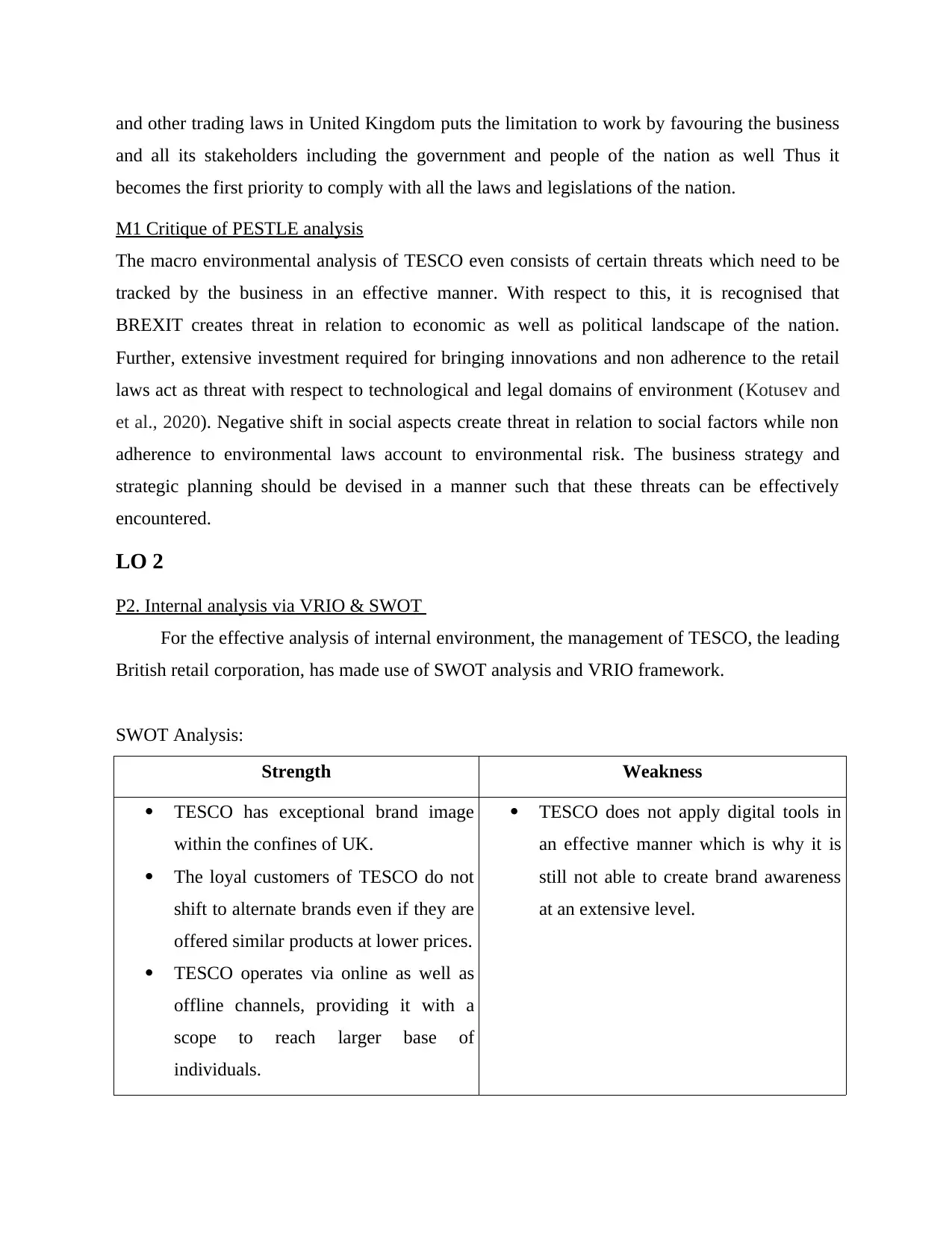
and other trading laws in United Kingdom puts the limitation to work by favouring the business
and all its stakeholders including the government and people of the nation as well Thus it
becomes the first priority to comply with all the laws and legislations of the nation.
M1 Critique of PESTLE analysis
The macro environmental analysis of TESCO even consists of certain threats which need to be
tracked by the business in an effective manner. With respect to this, it is recognised that
BREXIT creates threat in relation to economic as well as political landscape of the nation.
Further, extensive investment required for bringing innovations and non adherence to the retail
laws act as threat with respect to technological and legal domains of environment (Kotusev and
et al., 2020). Negative shift in social aspects create threat in relation to social factors while non
adherence to environmental laws account to environmental risk. The business strategy and
strategic planning should be devised in a manner such that these threats can be effectively
encountered.
LO 2
P2. Internal analysis via VRIO & SWOT
For the effective analysis of internal environment, the management of TESCO, the leading
British retail corporation, has made use of SWOT analysis and VRIO framework.
SWOT Analysis:
Strength Weakness
TESCO has exceptional brand image
within the confines of UK.
The loyal customers of TESCO do not
shift to alternate brands even if they are
offered similar products at lower prices.
TESCO operates via online as well as
offline channels, providing it with a
scope to reach larger base of
individuals.
TESCO does not apply digital tools in
an effective manner which is why it is
still not able to create brand awareness
at an extensive level.
and all its stakeholders including the government and people of the nation as well Thus it
becomes the first priority to comply with all the laws and legislations of the nation.
M1 Critique of PESTLE analysis
The macro environmental analysis of TESCO even consists of certain threats which need to be
tracked by the business in an effective manner. With respect to this, it is recognised that
BREXIT creates threat in relation to economic as well as political landscape of the nation.
Further, extensive investment required for bringing innovations and non adherence to the retail
laws act as threat with respect to technological and legal domains of environment (Kotusev and
et al., 2020). Negative shift in social aspects create threat in relation to social factors while non
adherence to environmental laws account to environmental risk. The business strategy and
strategic planning should be devised in a manner such that these threats can be effectively
encountered.
LO 2
P2. Internal analysis via VRIO & SWOT
For the effective analysis of internal environment, the management of TESCO, the leading
British retail corporation, has made use of SWOT analysis and VRIO framework.
SWOT Analysis:
Strength Weakness
TESCO has exceptional brand image
within the confines of UK.
The loyal customers of TESCO do not
shift to alternate brands even if they are
offered similar products at lower prices.
TESCO operates via online as well as
offline channels, providing it with a
scope to reach larger base of
individuals.
TESCO does not apply digital tools in
an effective manner which is why it is
still not able to create brand awareness
at an extensive level.
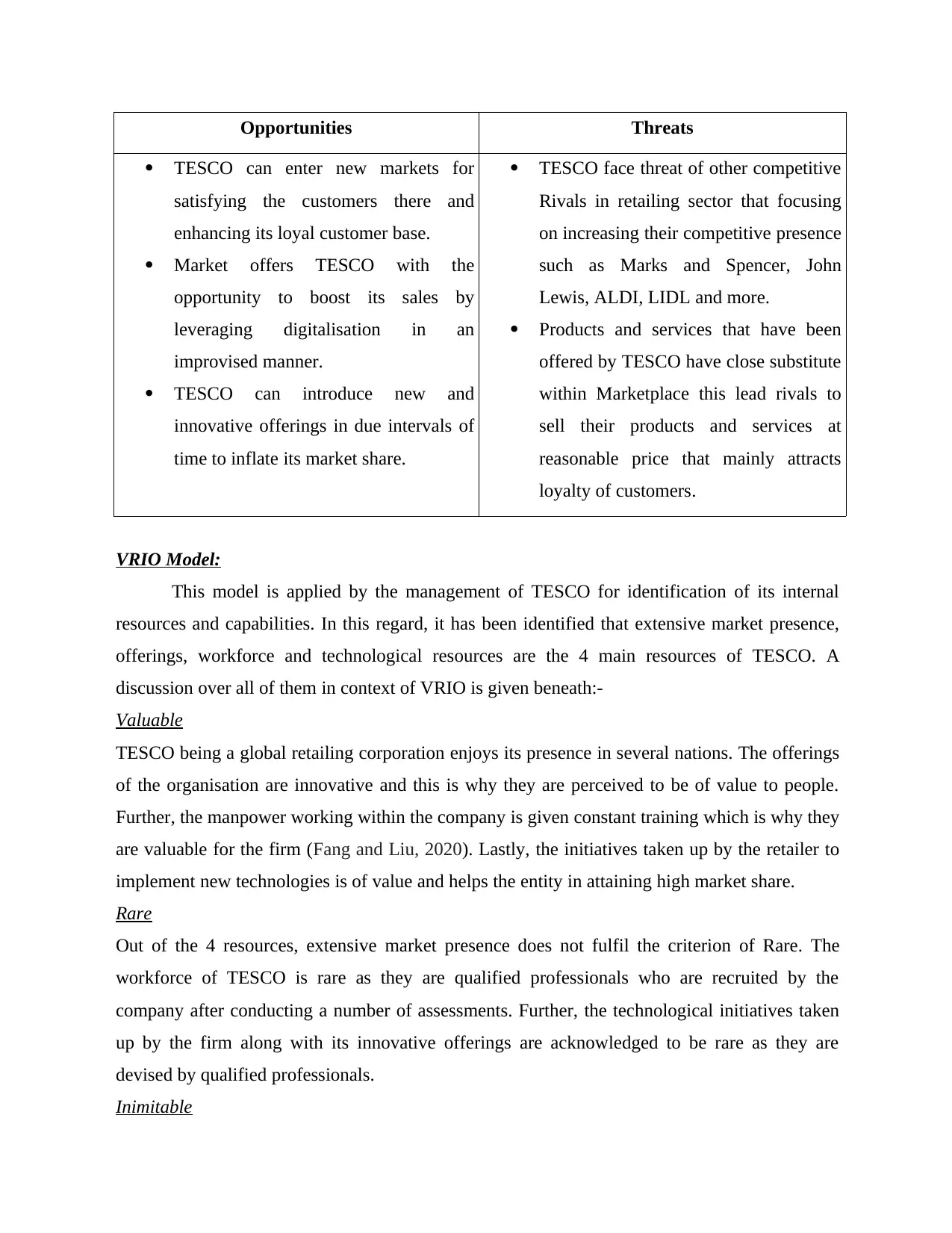
Opportunities Threats
TESCO can enter new markets for
satisfying the customers there and
enhancing its loyal customer base.
Market offers TESCO with the
opportunity to boost its sales by
leveraging digitalisation in an
improvised manner.
TESCO can introduce new and
innovative offerings in due intervals of
time to inflate its market share.
TESCO face threat of other competitive
Rivals in retailing sector that focusing
on increasing their competitive presence
such as Marks and Spencer, John
Lewis, ALDI, LIDL and more.
Products and services that have been
offered by TESCO have close substitute
within Marketplace this lead rivals to
sell their products and services at
reasonable price that mainly attracts
loyalty of customers.
VRIO Model:
This model is applied by the management of TESCO for identification of its internal
resources and capabilities. In this regard, it has been identified that extensive market presence,
offerings, workforce and technological resources are the 4 main resources of TESCO. A
discussion over all of them in context of VRIO is given beneath:-
Valuable
TESCO being a global retailing corporation enjoys its presence in several nations. The offerings
of the organisation are innovative and this is why they are perceived to be of value to people.
Further, the manpower working within the company is given constant training which is why they
are valuable for the firm (Fang and Liu, 2020). Lastly, the initiatives taken up by the retailer to
implement new technologies is of value and helps the entity in attaining high market share.
Rare
Out of the 4 resources, extensive market presence does not fulfil the criterion of Rare. The
workforce of TESCO is rare as they are qualified professionals who are recruited by the
company after conducting a number of assessments. Further, the technological initiatives taken
up by the firm along with its innovative offerings are acknowledged to be rare as they are
devised by qualified professionals.
Inimitable
TESCO can enter new markets for
satisfying the customers there and
enhancing its loyal customer base.
Market offers TESCO with the
opportunity to boost its sales by
leveraging digitalisation in an
improvised manner.
TESCO can introduce new and
innovative offerings in due intervals of
time to inflate its market share.
TESCO face threat of other competitive
Rivals in retailing sector that focusing
on increasing their competitive presence
such as Marks and Spencer, John
Lewis, ALDI, LIDL and more.
Products and services that have been
offered by TESCO have close substitute
within Marketplace this lead rivals to
sell their products and services at
reasonable price that mainly attracts
loyalty of customers.
VRIO Model:
This model is applied by the management of TESCO for identification of its internal
resources and capabilities. In this regard, it has been identified that extensive market presence,
offerings, workforce and technological resources are the 4 main resources of TESCO. A
discussion over all of them in context of VRIO is given beneath:-
Valuable
TESCO being a global retailing corporation enjoys its presence in several nations. The offerings
of the organisation are innovative and this is why they are perceived to be of value to people.
Further, the manpower working within the company is given constant training which is why they
are valuable for the firm (Fang and Liu, 2020). Lastly, the initiatives taken up by the retailer to
implement new technologies is of value and helps the entity in attaining high market share.
Rare
Out of the 4 resources, extensive market presence does not fulfil the criterion of Rare. The
workforce of TESCO is rare as they are qualified professionals who are recruited by the
company after conducting a number of assessments. Further, the technological initiatives taken
up by the firm along with its innovative offerings are acknowledged to be rare as they are
devised by qualified professionals.
Inimitable
Paraphrase This Document
Need a fresh take? Get an instant paraphrase of this document with our AI Paraphraser
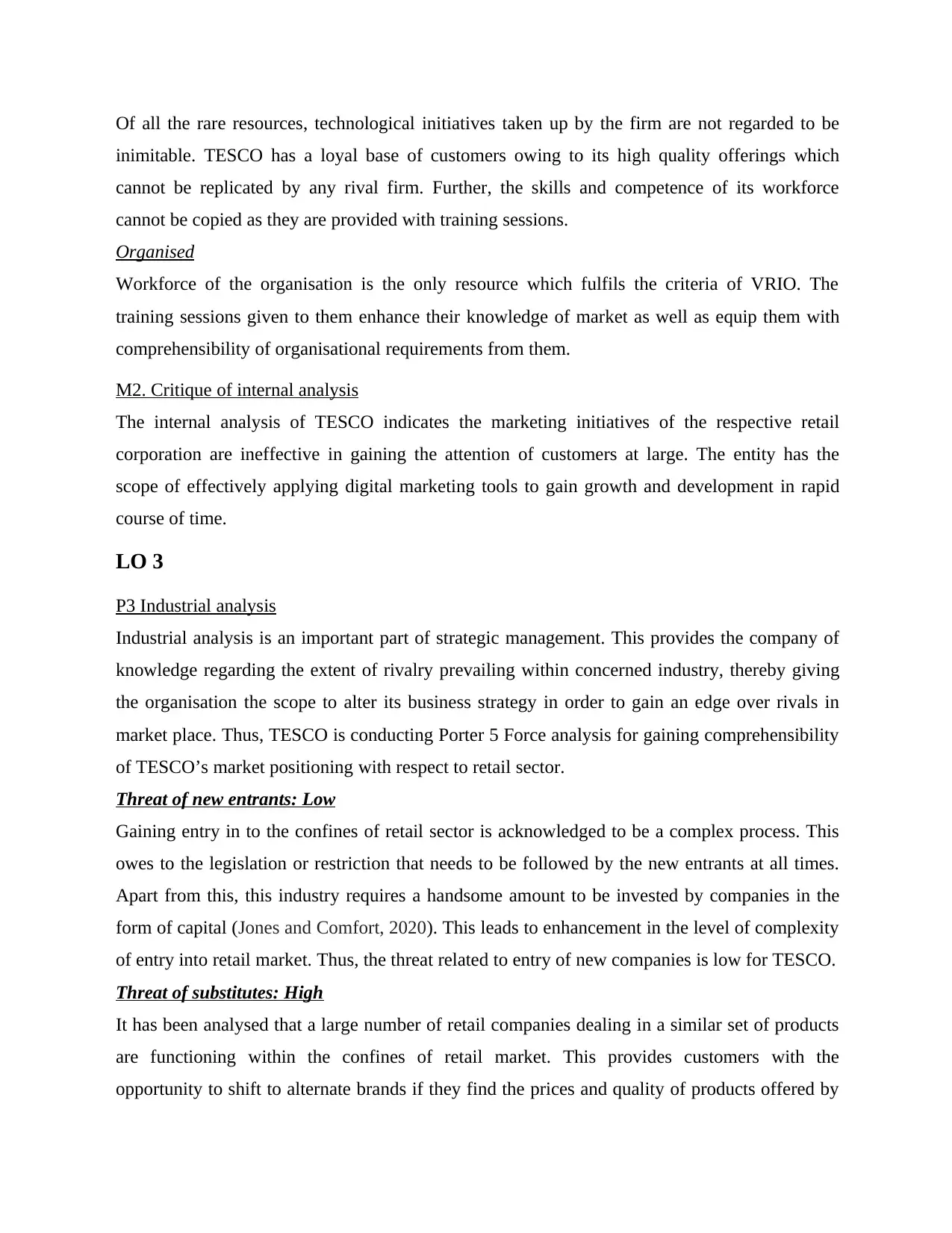
Of all the rare resources, technological initiatives taken up by the firm are not regarded to be
inimitable. TESCO has a loyal base of customers owing to its high quality offerings which
cannot be replicated by any rival firm. Further, the skills and competence of its workforce
cannot be copied as they are provided with training sessions.
Organised
Workforce of the organisation is the only resource which fulfils the criteria of VRIO. The
training sessions given to them enhance their knowledge of market as well as equip them with
comprehensibility of organisational requirements from them.
M2. Critique of internal analysis
The internal analysis of TESCO indicates the marketing initiatives of the respective retail
corporation are ineffective in gaining the attention of customers at large. The entity has the
scope of effectively applying digital marketing tools to gain growth and development in rapid
course of time.
LO 3
P3 Industrial analysis
Industrial analysis is an important part of strategic management. This provides the company of
knowledge regarding the extent of rivalry prevailing within concerned industry, thereby giving
the organisation the scope to alter its business strategy in order to gain an edge over rivals in
market place. Thus, TESCO is conducting Porter 5 Force analysis for gaining comprehensibility
of TESCO’s market positioning with respect to retail sector.
Threat of new entrants: Low
Gaining entry in to the confines of retail sector is acknowledged to be a complex process. This
owes to the legislation or restriction that needs to be followed by the new entrants at all times.
Apart from this, this industry requires a handsome amount to be invested by companies in the
form of capital (Jones and Comfort, 2020). This leads to enhancement in the level of complexity
of entry into retail market. Thus, the threat related to entry of new companies is low for TESCO.
Threat of substitutes: High
It has been analysed that a large number of retail companies dealing in a similar set of products
are functioning within the confines of retail market. This provides customers with the
opportunity to shift to alternate brands if they find the prices and quality of products offered by
inimitable. TESCO has a loyal base of customers owing to its high quality offerings which
cannot be replicated by any rival firm. Further, the skills and competence of its workforce
cannot be copied as they are provided with training sessions.
Organised
Workforce of the organisation is the only resource which fulfils the criteria of VRIO. The
training sessions given to them enhance their knowledge of market as well as equip them with
comprehensibility of organisational requirements from them.
M2. Critique of internal analysis
The internal analysis of TESCO indicates the marketing initiatives of the respective retail
corporation are ineffective in gaining the attention of customers at large. The entity has the
scope of effectively applying digital marketing tools to gain growth and development in rapid
course of time.
LO 3
P3 Industrial analysis
Industrial analysis is an important part of strategic management. This provides the company of
knowledge regarding the extent of rivalry prevailing within concerned industry, thereby giving
the organisation the scope to alter its business strategy in order to gain an edge over rivals in
market place. Thus, TESCO is conducting Porter 5 Force analysis for gaining comprehensibility
of TESCO’s market positioning with respect to retail sector.
Threat of new entrants: Low
Gaining entry in to the confines of retail sector is acknowledged to be a complex process. This
owes to the legislation or restriction that needs to be followed by the new entrants at all times.
Apart from this, this industry requires a handsome amount to be invested by companies in the
form of capital (Jones and Comfort, 2020). This leads to enhancement in the level of complexity
of entry into retail market. Thus, the threat related to entry of new companies is low for TESCO.
Threat of substitutes: High
It has been analysed that a large number of retail companies dealing in a similar set of products
are functioning within the confines of retail market. This provides customers with the
opportunity to shift to alternate brands if they find the prices and quality of products offered by
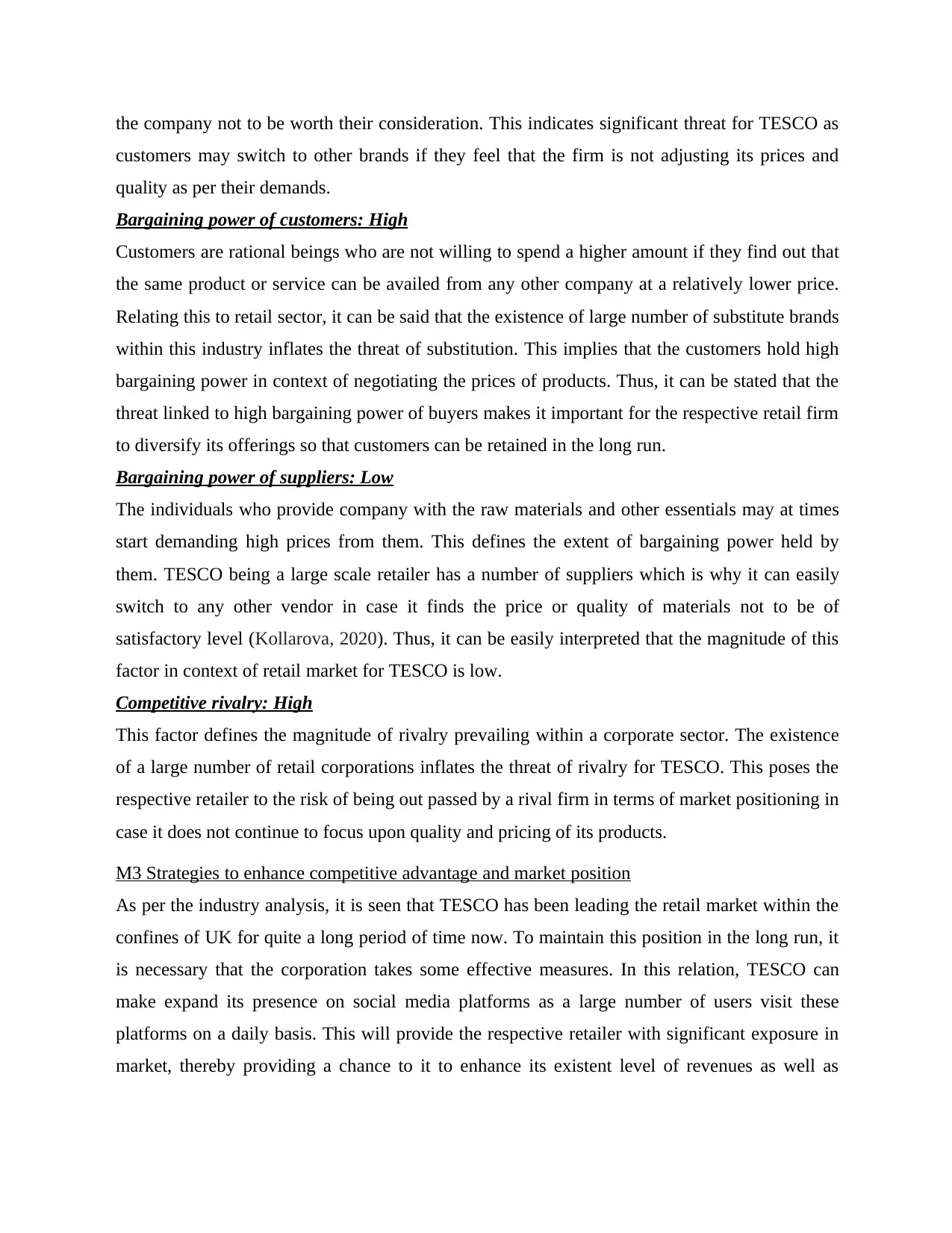
the company not to be worth their consideration. This indicates significant threat for TESCO as
customers may switch to other brands if they feel that the firm is not adjusting its prices and
quality as per their demands.
Bargaining power of customers: High
Customers are rational beings who are not willing to spend a higher amount if they find out that
the same product or service can be availed from any other company at a relatively lower price.
Relating this to retail sector, it can be said that the existence of large number of substitute brands
within this industry inflates the threat of substitution. This implies that the customers hold high
bargaining power in context of negotiating the prices of products. Thus, it can be stated that the
threat linked to high bargaining power of buyers makes it important for the respective retail firm
to diversify its offerings so that customers can be retained in the long run.
Bargaining power of suppliers: Low
The individuals who provide company with the raw materials and other essentials may at times
start demanding high prices from them. This defines the extent of bargaining power held by
them. TESCO being a large scale retailer has a number of suppliers which is why it can easily
switch to any other vendor in case it finds the price or quality of materials not to be of
satisfactory level (Kollarova, 2020). Thus, it can be easily interpreted that the magnitude of this
factor in context of retail market for TESCO is low.
Competitive rivalry: High
This factor defines the magnitude of rivalry prevailing within a corporate sector. The existence
of a large number of retail corporations inflates the threat of rivalry for TESCO. This poses the
respective retailer to the risk of being out passed by a rival firm in terms of market positioning in
case it does not continue to focus upon quality and pricing of its products.
M3 Strategies to enhance competitive advantage and market position
As per the industry analysis, it is seen that TESCO has been leading the retail market within the
confines of UK for quite a long period of time now. To maintain this position in the long run, it
is necessary that the corporation takes some effective measures. In this relation, TESCO can
make expand its presence on social media platforms as a large number of users visit these
platforms on a daily basis. This will provide the respective retailer with significant exposure in
market, thereby providing a chance to it to enhance its existent level of revenues as well as
customers may switch to other brands if they feel that the firm is not adjusting its prices and
quality as per their demands.
Bargaining power of customers: High
Customers are rational beings who are not willing to spend a higher amount if they find out that
the same product or service can be availed from any other company at a relatively lower price.
Relating this to retail sector, it can be said that the existence of large number of substitute brands
within this industry inflates the threat of substitution. This implies that the customers hold high
bargaining power in context of negotiating the prices of products. Thus, it can be stated that the
threat linked to high bargaining power of buyers makes it important for the respective retail firm
to diversify its offerings so that customers can be retained in the long run.
Bargaining power of suppliers: Low
The individuals who provide company with the raw materials and other essentials may at times
start demanding high prices from them. This defines the extent of bargaining power held by
them. TESCO being a large scale retailer has a number of suppliers which is why it can easily
switch to any other vendor in case it finds the price or quality of materials not to be of
satisfactory level (Kollarova, 2020). Thus, it can be easily interpreted that the magnitude of this
factor in context of retail market for TESCO is low.
Competitive rivalry: High
This factor defines the magnitude of rivalry prevailing within a corporate sector. The existence
of a large number of retail corporations inflates the threat of rivalry for TESCO. This poses the
respective retailer to the risk of being out passed by a rival firm in terms of market positioning in
case it does not continue to focus upon quality and pricing of its products.
M3 Strategies to enhance competitive advantage and market position
As per the industry analysis, it is seen that TESCO has been leading the retail market within the
confines of UK for quite a long period of time now. To maintain this position in the long run, it
is necessary that the corporation takes some effective measures. In this relation, TESCO can
make expand its presence on social media platforms as a large number of users visit these
platforms on a daily basis. This will provide the respective retailer with significant exposure in
market, thereby providing a chance to it to enhance its existent level of revenues as well as
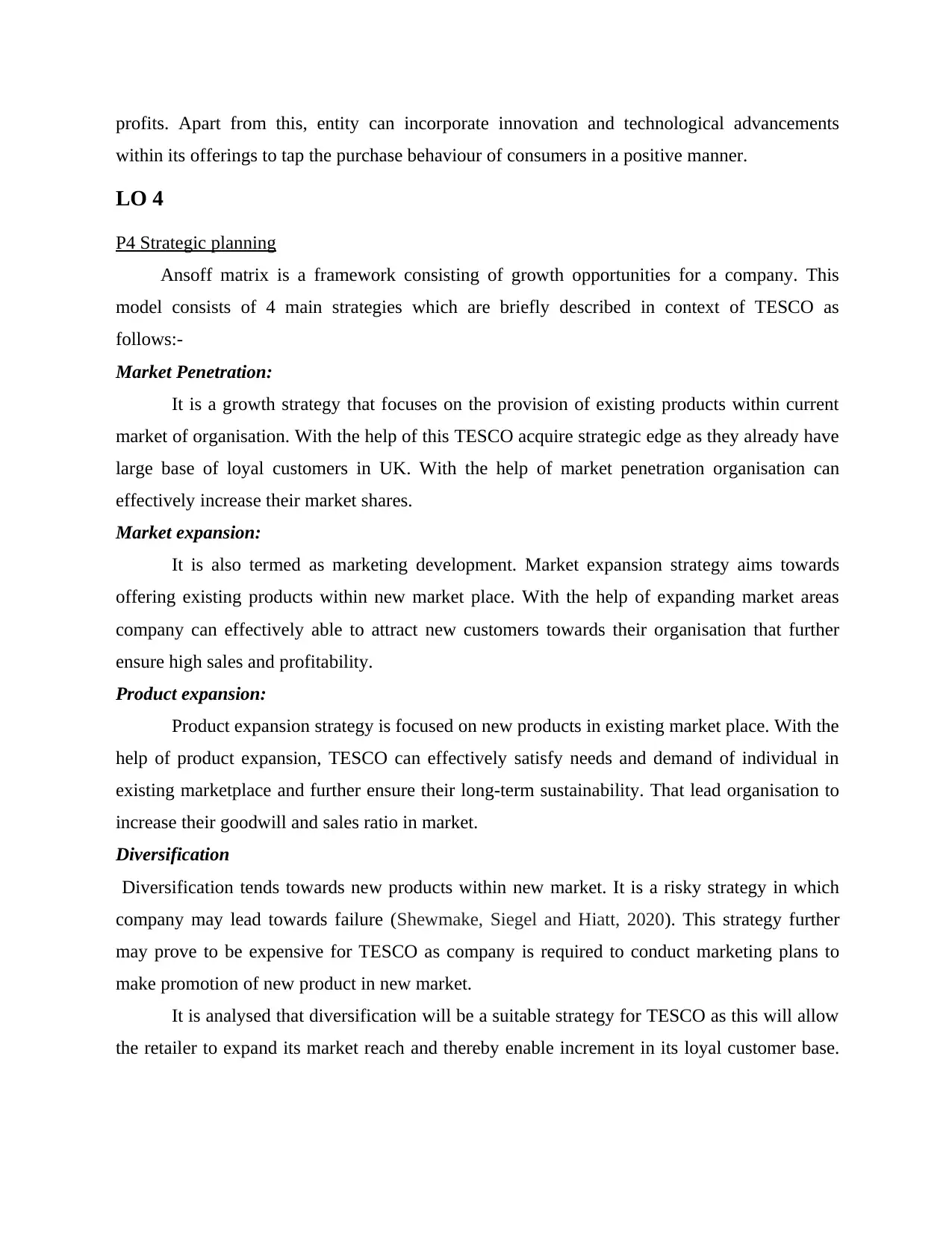
profits. Apart from this, entity can incorporate innovation and technological advancements
within its offerings to tap the purchase behaviour of consumers in a positive manner.
LO 4
P4 Strategic planning
Ansoff matrix is a framework consisting of growth opportunities for a company. This
model consists of 4 main strategies which are briefly described in context of TESCO as
follows:-
Market Penetration:
It is a growth strategy that focuses on the provision of existing products within current
market of organisation. With the help of this TESCO acquire strategic edge as they already have
large base of loyal customers in UK. With the help of market penetration organisation can
effectively increase their market shares.
Market expansion:
It is also termed as marketing development. Market expansion strategy aims towards
offering existing products within new market place. With the help of expanding market areas
company can effectively able to attract new customers towards their organisation that further
ensure high sales and profitability.
Product expansion:
Product expansion strategy is focused on new products in existing market place. With the
help of product expansion, TESCO can effectively satisfy needs and demand of individual in
existing marketplace and further ensure their long-term sustainability. That lead organisation to
increase their goodwill and sales ratio in market.
Diversification
Diversification tends towards new products within new market. It is a risky strategy in which
company may lead towards failure (Shewmake, Siegel and Hiatt, 2020). This strategy further
may prove to be expensive for TESCO as company is required to conduct marketing plans to
make promotion of new product in new market.
It is analysed that diversification will be a suitable strategy for TESCO as this will allow
the retailer to expand its market reach and thereby enable increment in its loyal customer base.
within its offerings to tap the purchase behaviour of consumers in a positive manner.
LO 4
P4 Strategic planning
Ansoff matrix is a framework consisting of growth opportunities for a company. This
model consists of 4 main strategies which are briefly described in context of TESCO as
follows:-
Market Penetration:
It is a growth strategy that focuses on the provision of existing products within current
market of organisation. With the help of this TESCO acquire strategic edge as they already have
large base of loyal customers in UK. With the help of market penetration organisation can
effectively increase their market shares.
Market expansion:
It is also termed as marketing development. Market expansion strategy aims towards
offering existing products within new market place. With the help of expanding market areas
company can effectively able to attract new customers towards their organisation that further
ensure high sales and profitability.
Product expansion:
Product expansion strategy is focused on new products in existing market place. With the
help of product expansion, TESCO can effectively satisfy needs and demand of individual in
existing marketplace and further ensure their long-term sustainability. That lead organisation to
increase their goodwill and sales ratio in market.
Diversification
Diversification tends towards new products within new market. It is a risky strategy in which
company may lead towards failure (Shewmake, Siegel and Hiatt, 2020). This strategy further
may prove to be expensive for TESCO as company is required to conduct marketing plans to
make promotion of new product in new market.
It is analysed that diversification will be a suitable strategy for TESCO as this will allow
the retailer to expand its market reach and thereby enable increment in its loyal customer base.
Secure Best Marks with AI Grader
Need help grading? Try our AI Grader for instant feedback on your assignments.
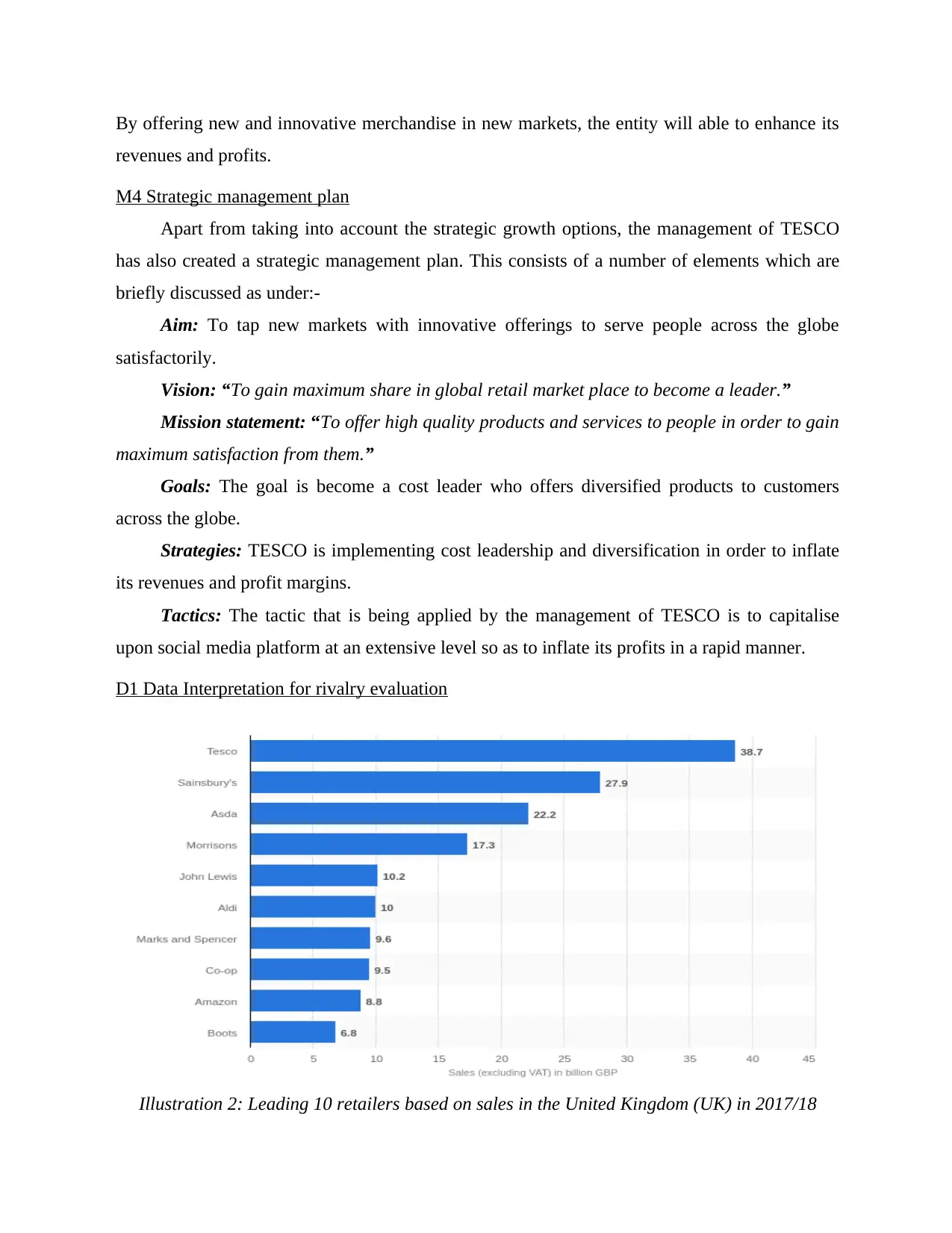
By offering new and innovative merchandise in new markets, the entity will able to enhance its
revenues and profits.
M4 Strategic management plan
Apart from taking into account the strategic growth options, the management of TESCO
has also created a strategic management plan. This consists of a number of elements which are
briefly discussed as under:-
Aim: To tap new markets with innovative offerings to serve people across the globe
satisfactorily.
Vision: “To gain maximum share in global retail market place to become a leader.”
Mission statement: “To offer high quality products and services to people in order to gain
maximum satisfaction from them.”
Goals: The goal is become a cost leader who offers diversified products to customers
across the globe.
Strategies: TESCO is implementing cost leadership and diversification in order to inflate
its revenues and profit margins.
Tactics: The tactic that is being applied by the management of TESCO is to capitalise
upon social media platform at an extensive level so as to inflate its profits in a rapid manner.
D1 Data Interpretation for rivalry evaluation
Illustration 2: Leading 10 retailers based on sales in the United Kingdom (UK) in 2017/18
revenues and profits.
M4 Strategic management plan
Apart from taking into account the strategic growth options, the management of TESCO
has also created a strategic management plan. This consists of a number of elements which are
briefly discussed as under:-
Aim: To tap new markets with innovative offerings to serve people across the globe
satisfactorily.
Vision: “To gain maximum share in global retail market place to become a leader.”
Mission statement: “To offer high quality products and services to people in order to gain
maximum satisfaction from them.”
Goals: The goal is become a cost leader who offers diversified products to customers
across the globe.
Strategies: TESCO is implementing cost leadership and diversification in order to inflate
its revenues and profit margins.
Tactics: The tactic that is being applied by the management of TESCO is to capitalise
upon social media platform at an extensive level so as to inflate its profits in a rapid manner.
D1 Data Interpretation for rivalry evaluation
Illustration 2: Leading 10 retailers based on sales in the United Kingdom (UK) in 2017/18
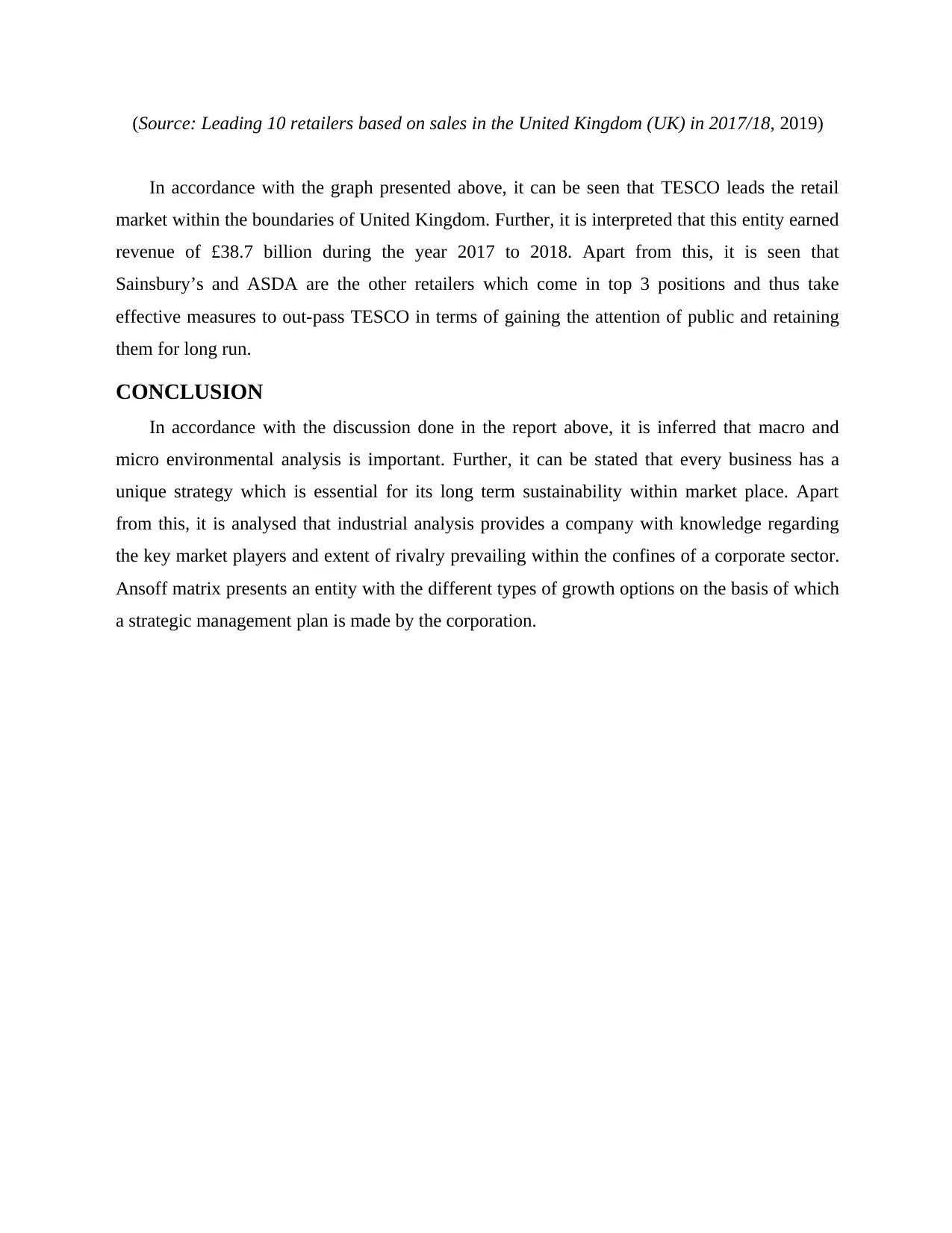
(Source: Leading 10 retailers based on sales in the United Kingdom (UK) in 2017/18, 2019)
In accordance with the graph presented above, it can be seen that TESCO leads the retail
market within the boundaries of United Kingdom. Further, it is interpreted that this entity earned
revenue of £38.7 billion during the year 2017 to 2018. Apart from this, it is seen that
Sainsbury’s and ASDA are the other retailers which come in top 3 positions and thus take
effective measures to out-pass TESCO in terms of gaining the attention of public and retaining
them for long run.
CONCLUSION
In accordance with the discussion done in the report above, it is inferred that macro and
micro environmental analysis is important. Further, it can be stated that every business has a
unique strategy which is essential for its long term sustainability within market place. Apart
from this, it is analysed that industrial analysis provides a company with knowledge regarding
the key market players and extent of rivalry prevailing within the confines of a corporate sector.
Ansoff matrix presents an entity with the different types of growth options on the basis of which
a strategic management plan is made by the corporation.
In accordance with the graph presented above, it can be seen that TESCO leads the retail
market within the boundaries of United Kingdom. Further, it is interpreted that this entity earned
revenue of £38.7 billion during the year 2017 to 2018. Apart from this, it is seen that
Sainsbury’s and ASDA are the other retailers which come in top 3 positions and thus take
effective measures to out-pass TESCO in terms of gaining the attention of public and retaining
them for long run.
CONCLUSION
In accordance with the discussion done in the report above, it is inferred that macro and
micro environmental analysis is important. Further, it can be stated that every business has a
unique strategy which is essential for its long term sustainability within market place. Apart
from this, it is analysed that industrial analysis provides a company with knowledge regarding
the key market players and extent of rivalry prevailing within the confines of a corporate sector.
Ansoff matrix presents an entity with the different types of growth options on the basis of which
a strategic management plan is made by the corporation.
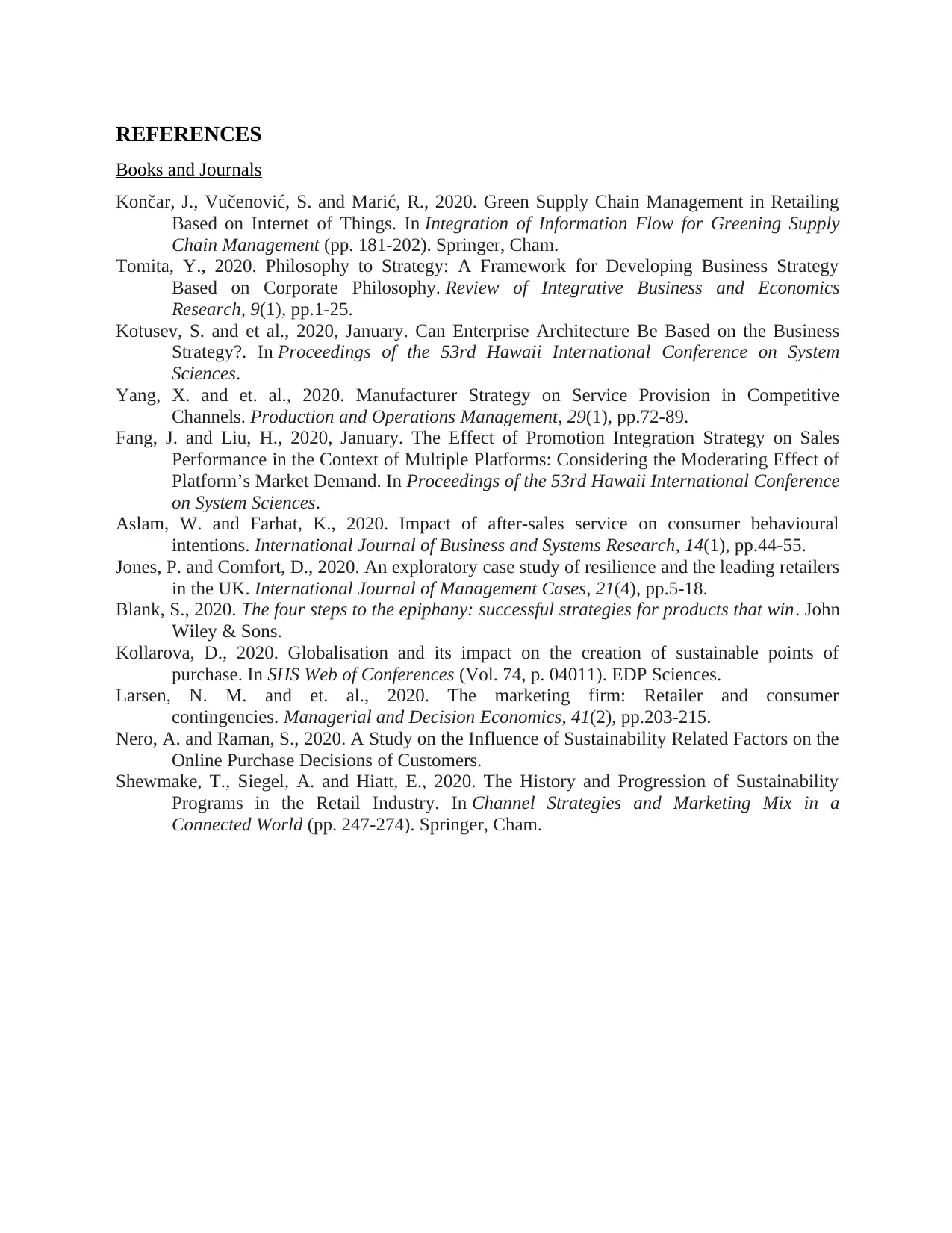
REFERENCES
Books and Journals
Končar, J., Vučenović, S. and Marić, R., 2020. Green Supply Chain Management in Retailing
Based on Internet of Things. In Integration of Information Flow for Greening Supply
Chain Management (pp. 181-202). Springer, Cham.
Tomita, Y., 2020. Philosophy to Strategy: A Framework for Developing Business Strategy
Based on Corporate Philosophy. Review of Integrative Business and Economics
Research, 9(1), pp.1-25.
Kotusev, S. and et al., 2020, January. Can Enterprise Architecture Be Based on the Business
Strategy?. In Proceedings of the 53rd Hawaii International Conference on System
Sciences.
Yang, X. and et. al., 2020. Manufacturer Strategy on Service Provision in Competitive
Channels. Production and Operations Management, 29(1), pp.72-89.
Fang, J. and Liu, H., 2020, January. The Effect of Promotion Integration Strategy on Sales
Performance in the Context of Multiple Platforms: Considering the Moderating Effect of
Platform’s Market Demand. In Proceedings of the 53rd Hawaii International Conference
on System Sciences.
Aslam, W. and Farhat, K., 2020. Impact of after-sales service on consumer behavioural
intentions. International Journal of Business and Systems Research, 14(1), pp.44-55.
Jones, P. and Comfort, D., 2020. An exploratory case study of resilience and the leading retailers
in the UK. International Journal of Management Cases, 21(4), pp.5-18.
Blank, S., 2020. The four steps to the epiphany: successful strategies for products that win. John
Wiley & Sons.
Kollarova, D., 2020. Globalisation and its impact on the creation of sustainable points of
purchase. In SHS Web of Conferences (Vol. 74, p. 04011). EDP Sciences.
Larsen, N. M. and et. al., 2020. The marketing firm: Retailer and consumer
contingencies. Managerial and Decision Economics, 41(2), pp.203-215.
Nero, A. and Raman, S., 2020. A Study on the Influence of Sustainability Related Factors on the
Online Purchase Decisions of Customers.
Shewmake, T., Siegel, A. and Hiatt, E., 2020. The History and Progression of Sustainability
Programs in the Retail Industry. In Channel Strategies and Marketing Mix in a
Connected World (pp. 247-274). Springer, Cham.
Books and Journals
Končar, J., Vučenović, S. and Marić, R., 2020. Green Supply Chain Management in Retailing
Based on Internet of Things. In Integration of Information Flow for Greening Supply
Chain Management (pp. 181-202). Springer, Cham.
Tomita, Y., 2020. Philosophy to Strategy: A Framework for Developing Business Strategy
Based on Corporate Philosophy. Review of Integrative Business and Economics
Research, 9(1), pp.1-25.
Kotusev, S. and et al., 2020, January. Can Enterprise Architecture Be Based on the Business
Strategy?. In Proceedings of the 53rd Hawaii International Conference on System
Sciences.
Yang, X. and et. al., 2020. Manufacturer Strategy on Service Provision in Competitive
Channels. Production and Operations Management, 29(1), pp.72-89.
Fang, J. and Liu, H., 2020, January. The Effect of Promotion Integration Strategy on Sales
Performance in the Context of Multiple Platforms: Considering the Moderating Effect of
Platform’s Market Demand. In Proceedings of the 53rd Hawaii International Conference
on System Sciences.
Aslam, W. and Farhat, K., 2020. Impact of after-sales service on consumer behavioural
intentions. International Journal of Business and Systems Research, 14(1), pp.44-55.
Jones, P. and Comfort, D., 2020. An exploratory case study of resilience and the leading retailers
in the UK. International Journal of Management Cases, 21(4), pp.5-18.
Blank, S., 2020. The four steps to the epiphany: successful strategies for products that win. John
Wiley & Sons.
Kollarova, D., 2020. Globalisation and its impact on the creation of sustainable points of
purchase. In SHS Web of Conferences (Vol. 74, p. 04011). EDP Sciences.
Larsen, N. M. and et. al., 2020. The marketing firm: Retailer and consumer
contingencies. Managerial and Decision Economics, 41(2), pp.203-215.
Nero, A. and Raman, S., 2020. A Study on the Influence of Sustainability Related Factors on the
Online Purchase Decisions of Customers.
Shewmake, T., Siegel, A. and Hiatt, E., 2020. The History and Progression of Sustainability
Programs in the Retail Industry. In Channel Strategies and Marketing Mix in a
Connected World (pp. 247-274). Springer, Cham.
1 out of 13
Related Documents
Your All-in-One AI-Powered Toolkit for Academic Success.
+13062052269
info@desklib.com
Available 24*7 on WhatsApp / Email
![[object Object]](/_next/static/media/star-bottom.7253800d.svg)
Unlock your academic potential
© 2024 | Zucol Services PVT LTD | All rights reserved.



